高阶
选项组
让你的 Markdown 文件支持选项卡。
你需要将选项卡包装在 tabs 容器中。
你可以在 tabs 容器中添加一个 id 后缀,该后缀将用作选项卡 id。 所有具有相同 id 的选项卡将共享相同的切换事件。
::: tabs#fruit
<!-- 这里,fruit 将用作 id,它是可选的 -->
<!-- 选项卡内容 -->
:::在这个容器内,你应该使用 @tab 标记来标记和分隔选项卡内容。
在 @tab 标记后,你可以添加文本 :active 默认激活选项卡,之后的文本将被解析为选项卡标题。
::: tabs
@tab 标题 1
<!-- tab 1 内容 -->
@tab 标题 2
<!-- tab 2 内容 -->
@tab:active 标题 3
<!-- tab 3 将会被默认激活 -->
<!-- tab 3 内容 -->
:::默认情况下,标题将用作选项卡的值,但你可以使用 id 后缀覆盖它。
::: tabs
@tab 标题 1
<!-- 此处,选项卡 1 的标题“标题 1”将用作值。 -->
<!-- tab 1 内容 -->
@tab 标题 2#值 2
<!-- 这里,tab 2 的标题将是 “标题 2”,但它会使用 “值 2” 作为选项卡的值-->
<!-- tab 2 内容 -->
:::你可以在每个选项卡中使用 Vue 语法和组件,并且你可以访问 value 和 isActive, 表示选项卡的绑定值和选项卡是否处于激活状态。
输入
::: tabs
@tab npm
npm 应该与 Node.js 被一同安装。
@tab pnpm
```sh
corepack enable
corepack use pnpm@8
```
:::输出
npm 应该与 Node.js 被一同安装。
corepack enable
corepack use pnpm@8示例容器
有时候,你可能需要在 内容中补充一些 示例,但期望能与 其它内容 分隔开来呈现。 主题支持在 Markdown 文件中添加示例容器。
语法
::: demo-wrapper
添加你的示例
:::选项
title="xxx":标题no-padding:不添加内边距img: 仅包含图片时使用height="xxx": 高度
示例
仅包含图片:
::: demo-wrapper img no-padding

:::输出:

包含 markdown 语法:
::: demo-wrapper title="标题"
### 三级标题
这是示例容器中的内容。
:::输出:
标题
三级标题
这是示例容器中的内容。
包含 html /vue 代码:
::: demo-wrapper
<h1 class="your-demo-title">这是标题</h1>
<p class="your-demo-paragraph">这是段落</p>
<style>
.your-demo-title {
color: red;
}
.your-demo-paragraph {
color: blue;
}
</style>
:::输出:
这是标题
这是段落
can I use
在编写文章时, 提供嵌入 can-i-use WEB feature 各平台支持说明 的功能。
方便在描述某个 WEB feature 时,能更直观的表述 该特性的支持程度。
在你的 文章 markdown文件中,使用以下格式:
::: caniuse <feature> {browser_versions}
:::示例: 获取 css 伪类选择器 :dir() 在各个浏览器的支持情况图标:
::: caniuse css-matches-pseudo
:::效果:
语法
::: caniuse <feature> {browser_versions}
:::<feature>必填。 正确取值请参考 https://caniuse.bitsofco.de/
{browser_versions}可选。当前特性在多个版本中的支持情况。
默认值为:
{-2,-1,1}格式:
{number,number,...}取值范围为-5 ~ 3- 小于
0表示低于当前浏览器版本的支持情况 0表示当前浏览器版本的支持情况- 大于
0表示高于当前浏览器版本的支持情况
- 小于
导入文件
主题支持在 Markdown 文件中导入文件切片。
导入文件 默认不启用,你可以通过配置来启用它。
export default defineUserConfig({
theme: plumeTheme({
plugins: {
markdownEnhance: {
include: true,
},
}
})
})语法
使用 <!-- @include: filename --> 导入文件。
如果要部分导入文件,你可以指定导入的行数:
<!-- @include: filename{start-end} --><!-- @include: filename{start-} --><!-- @include: filename{-end} -->
同时你也可以导入文件区域:
<!-- @include: filename#region -->
文件区域
文件区域是 vscode 中的一个概念,区域内容被 #region 和 #endregion 注释包围。
<!doctype html>
<html lang="zh-CN">
<head>
<meta charset="UTF-8" />
<meta http-equiv="X-UA-Compatible" content="IE=edge" />
<meta name="viewport" content="width=device-width, initial-scale=1.0" />
<title>Document</title>
</head>
<body>
<!-- region snippet -->
<p>
Lorem ipsum dolor, sit amet consectetur adipisicing elit. Eligendi,
repellendus. Voluptatibus alias cupiditate at, fuga tenetur error officiis
provident quisquam autem, porro facere! Neque quibusdam animi quaerat
eligendi recusandae eaque.
</p>
<!-- endregion snippet -->
<p>
Veniam harum illum natus omnis necessitatibus numquam architecto eum
dignissimos, quos a adipisci et non quam maxime repellendus alias ipsum,
vero praesentium laborum commodi perferendis velit repellat? Vero,
cupiditate sequi.
</p>
</body>
</html>## Hello world
<!-- #region snippet -->
Lorem ipsum dolor sit amet consectetur adipisicing elit. Voluptates
inventore iure quo aut doloremque, ipsum ab voluptatem ipsa, velit laborum
illo quae omnis reiciendis hic, ut dolorem non debitis in!
<!-- #endregion snippet -->
Veniam harum illum natus omnis necessitatibus numquam architecto eum
dignissimos, quos a adipisci et non quam maxime repellendus alias ipsum,
vero praesentium laborum commodi perferendis velit repellat? Vero,
cupiditate sequi.import MarkdownIt from 'markdown-it'
import { include } from '@mdit/plugin-include'
// #region snippet
const mdIt = MarkdownIt().use(include, {
// your options, currentPath is required
currentPath: env => env.filePath,
})
// #endregion snippet
mdIt.render('<!-- @include: ./path/to/include/file.md -->', {
filePath: 'path/to/current/file.md',
})const MarkdownIt = require('markdown-it')
const { include } = require('@mdit/plugin-include')
// #region snippet
const mdIt = MarkdownIt().use(include, {
// your options, currentPath is required
currentPath: env => env.filePath,
})
// #endregion snippet
mdIt.render('<!-- @include: ./path/to/include/file.md -->', {
filePath: 'path/to/current/file.md',
})html,
body {
margin: 0;
padding: 0;
}
/* #region snippet */
h1 {
font-size: 1.5rem;
}
/* #endregion snippet */
h2 {
font-size: 1.2rem;
}html,
body {
margin: 0;
padding: 0;
}
/* #region snippet */
h1 {
font-size: 1.5rem;
}
/* #endregion snippet */
h2 {
font-size: 1.2rem;
}html,
body {
margin: 0;
padding: 0;
}
/* #region snippet */
h1 {
font-size: 1.5rem;
}
/* #endregion snippet */
h2 {
font-size: 1.2rem;
}public class HelloWorld {
// #region snippet
public static void main(String args[]){
System.out.println("Hello World");
}
// #endregion snippet
}class MyClass:
msg = "world"
#region snippet
def sayHello(self):
print("Hello " + self.msg + "!")
#region snippet
def sayBye(self):
print("Bye " + self.msg + "!")Imports System
Module Module1
# Region snippet
Sub Main()
Console.WriteLine("Hello World!")
Console.WriteLine("Press Enter Key to Exit.")
Console.ReadLine()
End Sub
# EndRegion
End Module>nul 2>&1 "%SYSTEMROOT%\system32\cacls.exe" "%SYSTEMROOT%\system32\config\system"
if '%errorlevel%' NEQ '0' (
echo Requesting administrative privileges...
goto UACPrompt
) else ( goto gotAdmin )
::#region snippet
:UACPrompt
echo Set UAC = CreateObject^("Shell.Application"^) > "%temp%\getadmin.vbs"
echo UAC.ShellExecute "%~s0", "", "", "runas", 1 >> "%temp%\getadmin.vbs"
"%temp%\getadmin.vbs"
exit /B
::#endregion snippet
:gotAdmin
if exist "%temp%\getadmin.vbs" ( del "%temp%\getadmin.vbs" )
pushd "%CD%"
CD /D "%~dp0"using System;
namespace HelloWorldApp {
class Geeks {
// #region snippet
static void Main(string[] args) {
// statement
// printing Hello World!
Console.WriteLine("Hello World!");
// To prevents the screen from
// running and closing quickly
Console.ReadKey();
}
// #endregion snippet
}
}#include <iostream>
#include <vector>
std::vector<int> v;
#pragma region snippet
int f() {
for (int item : v) std::cout << item << std::endl;
return v.size();
}
#pragma endregion snippet
int main() {
int n, u;
std::cin >> n;
for (int i = 1; i <= n; ++i) {
std::cin >> u;
v.push_back(u);
}
std::cout << f();
return 0;
}高级
你还可以设置一个对象来自定义包含文件路径和包含行为。
interface IncludeOptions {
/**
* 处理 include 文件路径
*
* @default (path) => path
*/
resolvePath?: (path: string, cwd: string | null) => string
/**
* 是否深度导入包含的 Markdown 文件
*
* @default false
*/
deep?: boolean
/**
* 是否使用 `<!-- @include: xxx -->` 代替 `@include: xxx` 导入文件
*
* @default true
*/
useComment?: boolean
/**
* 是否解析包含的 Markdown 文件的里的相对图像路径
*
* @default true
*/
resolveImagePath?: boolean
/**
* 是否解析包含的 Markdown 文件的里的文件相对路径
*
* @default true
*/
resolveLinkPath?: boolean
}例如: 你可以使用 @src 作为源文件夹的别名。
export default defineUserConfig({
theme: plumeTheme({
plugins: {
markdownEnhance: {
include: {
resolvePath: (file) => {
if (file.startsWith('@src'))
return file.replace('@src', path.resolve(__dirname, '..'))
return file
},
},
},
}
})
})此外,如果你想将 Markdown 文件直接放在实际文件旁边,但不希望它们呈现为页面, 你可以在 VuePress 配置中设置 pagePatterns 选项。 有关详细信息,请参阅 pagePatterns。
export default defineUserConfig({
// 现在任何带有 `.snippet.md` 扩展名的文件都不会呈现为页面
pagePatterns: ['**/*.md', '!**/*.snippet.md', '!.vuepress', '!node_modules'],
theme: plumeTheme({
plugins: {
markdownEnhance: {
include: true,
},
}
})
})示例
在项目中有一个 foo.snippet.md 文件:
### 三级标题
这是 foo.snippet.md 文件中的内容。
::: info
提示容器包括的内容
:::
<!-- region snippet -->
这里是被 `<!-- region snippet -->` 包裹的内容。
通过 `<!-- @include: ./foo.snippet.md#snippet -->` 来引入。
<!-- endregion snippet -->使用 <!-- @include: ./foo.snippet.md --> 导入文件:
Include by file
三级标题
这是 foo.snippet.md 文件中的内容。
相关信息
提示容器包括的内容
这里是被 <!-- region snippet --> 包裹的内容。
通过 <!-- @include: ./foo.snippet.md#snippet --> 来引入。
使用 <!-- @include: ./foo.snippet.md{5-7} --> 导入文件内的 5 到 7 行:
Include by lines
相关信息
提示容器包括的内容
使用 <!-- @include: ./foo.snippet.md#snippet --> 导入 snippet 区域
Include by file region
这里是被 <!-- region snippet --> 包裹的内容。
通过 <!-- @include: ./foo.snippet.md#snippet --> 来引入。
代码演示
代码演示 默认不启用,你可以通过配置来启用它。
export default defineUserConfig({
theme: plumeTheme({
plugins: {
markdownEnhance: {
demo: true,
},
}
})
})语法
::: [类型]-demo 可选的标题文字
```html
<!-- ↑ 使用可用的语言 -->
<!-- 在代码块中放置你对应语言的代码,一个语言不能出现多个块 -->
<!-- 你可以有多个代码块,并且 html, js, css 都是视情况可选的 -->
```
```json
// json block 作为插件配置存放处
{
// 放置你的配置 (可选的)
}
```
:::提示
JSON 块是可选的,可用的配置详见配置
插件支持三种类型
- normal(默认)
- vue
- react
可用的语言
你可以在演示块中使用不同语言。
当你设置一些不能在浏览器上直接运行的语言时,由于插件无法解析它们,因此网页演示将被禁用。插件只显示代码。同时提供一个 "在 CodePen 中打开" 按钮允许用户直接在 CodePen 打开并浏览代码。
可用的 HTML 语言:
"html"(默认)"slim""haml""markdown"
可用的 JS 语言:
"javascript"(default)"coffeescript""babel""livescript""typescript"
你也可以在代码块中使用
js,ts,coffee和ls。
可用的 CSS 语言:
"css"(default)"less""scss""sass""stylus"
不支持的语言
# 标题
十分强大const message: string = 'VuePress Theme Hope'
document.querySelector('h1').innerHTML = messageh1 {
font-style: italic;
+ p {
color: red;
}
}代码
::: normal-demo 一个使用浏览器不支持解析语言 Demo
```md
# 标题
十分强大
```
```ts
const message: string = 'VuePress Theme Hope'
document.querySelector('h1').innerHTML = message
```
```scss
h1 {
font-style: italic;
+ p {
color: red;
}
}
```
:::普通代码演示
格式:
::: normal-demo 可选的标题文字
```html
<!-- html code -->
```
```js
// js code
```
```css
/* css code */
```
```json
// 配置 (可选)
{
"jsLib": [
// ...
],
"cssLib": [
// ...
]
}
```
:::注意事项
我们使用 "ShadowDOM" 进行样式隔离,并已经将 document 替换为了 shadowRoot 对象。如果需要访问页面的 document,请访问 window.document。
例子
<h1>Hello Word!</h1>
<p><span id="very">非常</span>强大!</p>document.querySelector('#very').addEventListener('click', () => {
alert('非常强大')
})span {
color: red;
}代码
::: normal-demo Demo 演示
```html
<h1>Hello Word!</h1>
<p><span id="very">非常</span>强大!</p>
```
```js
document.querySelector('#very').addEventListener('click', () => {
alert('非常强大')
})
```
```css
span {
color: red;
}
```
:::Vue 代码演示
格式
::: vue-demo 可选的标题文字
```vue
<!-- ↑ 你也可以使用 html -->
<script>
export default {
// vue 组件
}
</script>
<template>
<!-- vue 模板 -->
<div>demo</div>
</template>
<style>
/* css 代码 */
</style>
```
```json
// 配置 (可选)
{}
```
:::注意事项
- 你只能使用
Vue3。 - 必须将组件通过
export default默认导出 - 我们使用
"ShadowDOM"进行样式隔离,并已经将document替换为了shadowRoot对象。如果需要访问页面的document,请访问window.document。
演示
<script>
const { ref } = Vue
export default {
setup() {
const message = ref('powerful')
const handler = () => {
message.value = `very ${message.value}`
}
return {
message,
handler,
}
},
}
</script>
<template>
<div class="box">
<code>Hello Word</code> is
<span @click="handler">{{ message }}</span>!
</div>
</template>
<style>
.box span {
color: red;
}
</style>代码
::: vue-demo 一个 Vue Composition 演示
```vue
<script>
const { ref } = Vue
export default {
setup() {
const message = ref('powerful')
const handler = () => {
message.value = `very ${message.value}`
}
return {
message,
handler,
}
},
}
</script>
<template>
<div class="box">
<code>Hello Word</code> is
<span @click="handler">{{ message }}</span>!
</div>
</template>
<style>
.box span {
color: red;
}
</style>
```
:::React 代码演示
格式
::: react-demo 可选的标题文字
```js
// 放置脚本,并通过 `export default` 导出你的 react 组件
```
```css
/* 你的 css 内容 */
```
```json
// 配置 (可选)
{}
```
:::注意事项
- 使用 React 的时候,为了解析 JSX 必须引入 Babel,此过程由插件自动完成。
- 必须将组件通过
export default默认导出 - 我们使用
"ShadowDOM"进行样式隔离,并已经将document替换为了shadowRoot对象。如果需要访问页面的document,请访问window.document。
演示
const { useState } = React
export default () => {
const [message, setMessage] = useState(' 强大')
const handler = () => {
setMessage(`十分${message}`)
}
return (
<div className="box">
<code>Hello Word !</code>
<span id="powerful" onClick={handler}>
{message}
</span>
</div>
)
}.box #powerful {
color: blue;
}代码
::: react-demo 一个函数式 React Demo
```js
const { useState } = React
export default () => {
const [message, setMessage] = useState(' 强大')
const handler = () => {
setMessage(`十分${message}`)
}
return (
<div className="box">
<code>Hello Word !</code>
<span id="powerful" onClick={handler}>
{message}
</span>
</div>
)
}
```
```css
.box #powerful {
color: blue;
}
```
:::